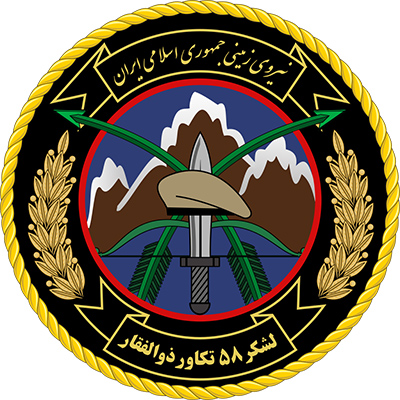Groups, Institutions, Organiza
Zulfaqar 58th Commando Division
Mohsen Shir-Muhammad
85 دورہ
The Zulfaqar 58th Commando Division was one of the key units of the Islamic Republic of Iran Army Ground Forces during the Iran-Iraq War. When Iraq invaded Iran, the Zulfaqar 58th Brigade was formed in Tehran’s Qasr Barracks by recruiting conscripts. Colonel Yaqoub Aliyari took the responsibility of organizing, training, and commanding the brigade which later on was deployed to the frontlines. The 58th Brigade had light equipment, and its forces were handpicked from elite personnel, including officers and conscripts of other units[1] including the 23rd Nohed Brigade.[2]
The Zulfaqar 58th Brigade consisted of the 1st, 2nd, 3rd, and 4th commando battalions, along with the 813th Artillery Battalion and an Air Defense Battalion.[3]
In December 1981, during Operation Matla al-Fajr, the Zulfaqar 58th Brigade developed a plan targeting a 10-kilometer advance behind enemy lines in the Shiakuh region.[4] The brigade was tasked with capturing the Charmian, Shiakuh, and Tang-e Kurk heights (on the Gilan-e Gharb to Qasr-e Shirin axis) and securing the defensive line along the Gilan-e Gharb River.[5] On December 11, 1981, Operation Matla al-Fajr began with the engagement of the 1st, 2nd, and 3rd battalions of the Zulfaqar 58th Brigade, alongside the 3rd Brigade of the 81st Kermanshah Division (Army), three battalions of the Islamic Revolutionary Guard Corps (IRGC), and a gendarmerie company.[6] The operation lasted 27 days, resulting in 1700 enemy casualties[7] and the liberation of the Chaghalvand and Avzin heights, as well as 30 square kilometers of occupied territory in the Gilan-e Gharb plain.[8]
In 1982 when Operation Fath al-Mobin was underway in Khuzestan, the Zulfaqar 58th Brigade was tasked with taking control of the eastern heights of Dasht-e Abbas and Tappeh Abu Salibi Khat. After seven days of fighting, the Iranian forces liberated approximately 2200 square kilometers of occupied territory, including Ain-e Khush, Ali Gereh-zad, Abu Salibi Khat, and Mishdagh.[9] Following the operation, until April 29, 1982, the brigade’s forces spread out across the Karkheh Kur, Do-Kuheh, Farsiyeh, and western Seyyed Jaber regions, covering an area of about 20 to 25 kilometers and defending key access routes to Ahvaz.[10]
In 1982, during Operation Beit al-Muqaddas which aimed at liberating Khorramshahr, the Zulfaqar 58th Commando Brigade, commanded by Colonel Yaqoub Aliyari, joined the units of the 41st Tharallah (as) Infantry Brigade, all operating under the command of the IRGC Quds 4 Headquarters.[11] Before the operation began, on April 22, 1982, Iraq attacked the brigade’s positions, to which Iranians responded.[12]
On April 30, Operation Beit al-Muqaddas started, and the 2nd Commando Infantry Battalion of the 58th Brigade was the first unit to reach the enemy’s defensive line.[13] Over the three phases of the operation, the Zulfaqar 58th Brigade managed to push into the Koushk and Talaiyeh borderlines, playing a key role in the liberation of Khorramshahr.[14]
On June 5, 1983, twelve days after the liberation of Khorramshahr, Israel invaded Lebanon. Consequently, the Supreme Defense Council decided to deploy the Zulfaqar 58th Brigade of the Army and the 27th Muhammad Rasulullah (pbuh) Brigade of the IRGC to Syria.[15] The Zulfaqar 58th Brigade returned to Iran three months later.[16]
In November 1982, the brigade participated in Operation Muharram in the western Ain-e Khush region, which resulted in the liberation of about 550 square kilometers of occupied Iranian territory and the capture of 300 square kilometers of Iraq.[17]
In October 1982, the 1st to 4th commando battalions of the Zulfaqar 58th Brigade, in addition to one tank battalion, and the mixed 381st Artillery Battalion (with two 155 mm self-propelled and one 105 mm batteries), were deployed to the defensive axis of Chenaneh, Khuzestan, to protect the area against enemy attacks.[18]
In February 1983, the Zulfaqar 58th Brigade under the Najaf Headquarters participated in Operation Preliminary Valfajr carried out in Fakkeh and Chazabeh.[19]
In April 1983, the brigade took part in Operation Valfajr 1 in northwestern Khuzestan.[20] With four infantry battalions, one tank battalion, and one artillery battalion under the Qaem Headquarters, it managed to keep the western Duweirij River and eastern Fakkeh region under Iranian control.[21] In October 1984, the Zulfaqar 58th Brigade was serving as a defensive unit across Changuleh to Shahrani.[22]
Until 1984, the operations were conducted jointly by the Army Ground Forces and the IRGC, after which each began to operate independently.[23] In July 1986, the 84th, 30th, and Zulfaqar 58th brigades were upgraded to divisions.[24]
The Zulfaqar 58th Division engaged in Operation Karbala 6, which was launched by the Army in January 1987 in the northern Summar. It resulted in the liberation of 40 square kilometers of Iranian territory.[25]
On July 22, 1988, during Iraq’s renewed large-scale offensive in western Iran (Qasr-e Shirin and surrounding areas), the Zulfaqar 58th Division, alongside the 81st Kermanshah Division, countered the enemy’s assault.[26]
Throughout the Iran-Iraq War, 1814 troops of the Zulfaqar 58th Division were martyred,[27] including Mostafa Pajoohandeh, commander of the 183rd Battalion.[28] Since 2011, under the Samen Plan, the structure of the Iranian Ground Force was reorganized, with brigades of each division operating independently in different regions.[29] The Zulfaqar 58th Division’s brigades were also became independent, with the 158th Brigade stationed in Shahroud and the 258th in Nehbandan, both of which now operate under the supervision of the Zulfaqar 58th Division’s headquarters.[30]
Major General Yaqoub Aliyari was the founder and first commander of the Zulfaqar 58th Division during the war.[31] Currently, Brigadier General Bahador Khajehvand Jafari commands the division.[32]
[1] Sait-e Javan-e Online (Javan Online Website), 27 Khordad 1399, www.javanonline.ir/fa/news/1007013
[2] Saeidamiri, Saeid va Afshin Javar, Takavaran (Commandos), Mahname Saf, No. 354, Ordibehesht 1389, p. 33.
[3] Babaei, Karim, Zolfaqar bar Sar-e Doshman (Zolfaqar Strikes the Enemy), Mahname Saf, No. 355, Khordad 1389, p. 37.
[4] Jafari, Mojtaba, Atlase Nabardha-ye Mandegar (Atlas of Lasting Battles), Tehran, Soore Sabz, 35th ed., 1392, p. 68.
[5] Hussaini, Seyyed Yaqoub, Amaliyat-e Shiakuh (Operation Shiakuh), Tehran, Iran Sabz, 1393, p. 147.
[6] Ibid., Pp. 145, 213.
[7] Jafari, Mojtaba, Ibid., p. 68.
[8] Amaliyat-e Matale al-Fajr Bozorgtarin Amaliyat-e Defa Muqaddas Bood (Operation Matale al-Fajr Was the Largest Sacred Defense Operation), Khabargozari Defa Muqaddas, 26 Azar 1403, https://defapress.ir/fa/news/713216
[9] Jafari, Mojtaba, Ibid., p. 74.
[10] Babaei, Karim, Ibid., p. 37.
[11] Ibid., p. 36.
[12] Ibid., p. 37.
[13] Ibid., p. 38.
[14] Ibid., p. 41.
[15] Khabargozari Fars (Fars News Agency), 14 Tir 1388, www.farsnews.ir/news/8804140433
[16] Khaterate Hojatoleslam Mohtashami Safire Sabeqe Iran dar Sourieh (Memoirs of Hojatoleslam Mohtashami, Former Iranian Ambassador to Syria), Keyhan Year 1365–1366, Vol. 2, Tehran, Entesharate Rouznameye Keyhan, 1367, p. 27.
[17] Jafari, Mojtaba, Ibid., p. 84.
[18] Najafi-Rashed, Muhammad, Topkhane dar Amaliyathaye Afandi va Mamuriyathaye Vijeh (Artillery in Offensive Operations and Special Missions), Tehran, Iran Sabz, 1397, p. 429.
[19] Hussaini, Seyyed Yaqoub, Amaliyat-e Valfajr Moqaddamati (Operation Preliminary Valfajr), Tehran, Heyate Maarefe Jang, 1389, Pp. 41–42.
[20] Jafari, Mojtaba, Ibid., p. 88.
[21] Hussaini, Seyyed Yaqoub, Nabardha-ye Sale 1362 ta Payane 1364 (Battles of 1983–1985), Tehran, Heyate Maarefe Jang, 1389, Pp. 33, 34, 45, 73.
[22] Ibid., p. 427.
[23] Alaei, Hussain, Ravande Jange Iran va Araq (The Course of the Iran–Iraq War), Vol. 2, Tehran, Marz o Boom, 1391, p. 120.
[24] Sadeqi-Goya, Nejatali, Chegouneh Mijangidim (How We Fought), Tehran, Iran Sabz, 1394, Pp. 353–354.
[25] Jafari, Mojtaba, Ibid., p. 134.
[26] Ibid., p. 158.
[27] Khabargozari Mehr (Mehr News Agency), 13 Azar 1399, www.mehrnews.com/news/5086987
[28] Bashgah-e Khabarnegaran-e Javan (Khabarnegaran-e Javan News Agency), 14 Bahman 1399, www.yjc.news/fa/news/7650340
[29] Rafiei, Ali va Digaran, Arzyabiye Mizan-e Chaboksaziye Tiphaye Mostaqelle Zerehi dar Tarh-e Samen Nirooye Zamini-ye Artesh-e Jomhouri-ye Eslami-ye Iran (Assessment of the Mechanization of Independent Armored Brigades in Samen Project of the Islamic Republic of Iran Army Ground Force), Faslname Oloum va Fonoun-e Nezami, No. 55, Bahar 1400, p. 171.
[30] Khabargozari Mehr (Mehr News Agency), 13 Azar 1399, www.mehrnews.com/news/5086987; Khabargozari Seda va Sima (IRIB News Agency), 30 Bahman 1399, www.iribnews.ir/fa/news/3023893
[31] Zendeginame Yaqoub Aliyari (Biography of Yaqoub Aliyari), Sait-e Hamshahri Online, 6 Mehr 1393, www.hamshahrionline.ir/news/273354
[32] Takrim va Moarefe Farmande-ye Qarargah-e Amaliyatiye Lashkar-e 58 Takavvare Zolfaqar-e Shahroud Bargozar Shod (Introduction and Farewell Ceremony of Commander of Shahroud’s 58 Zolfaqar Commando Division Operational Headquarters Was Held), Khabargozari Basij, 31 Mordad 1400, basijnews.ir/fa/news/9366632





